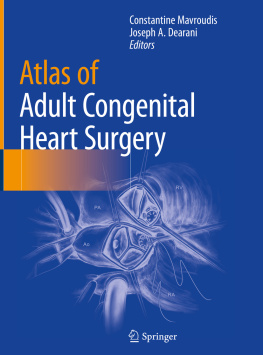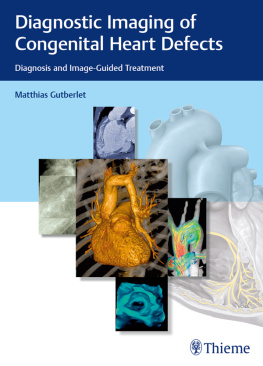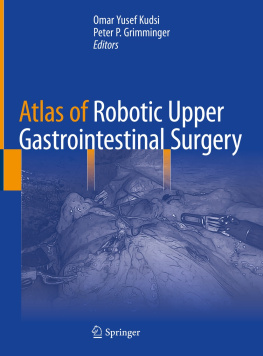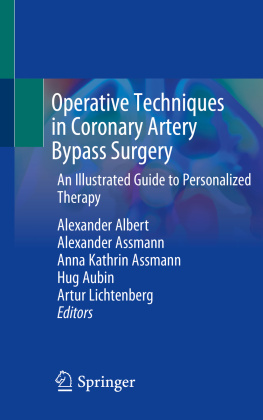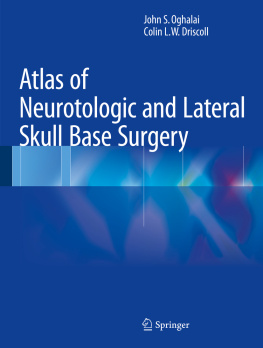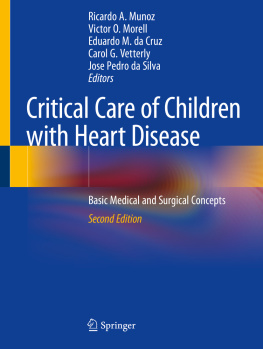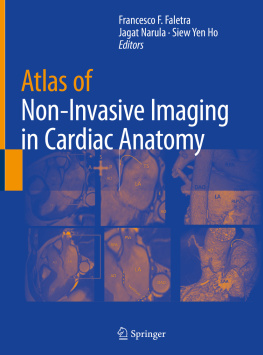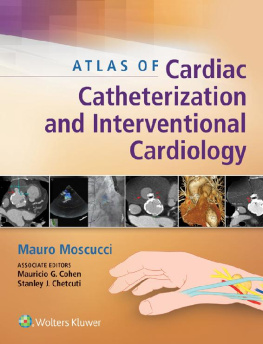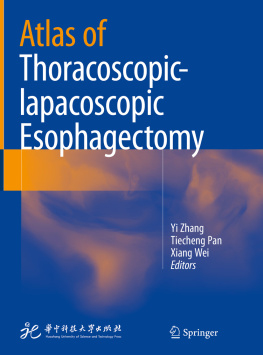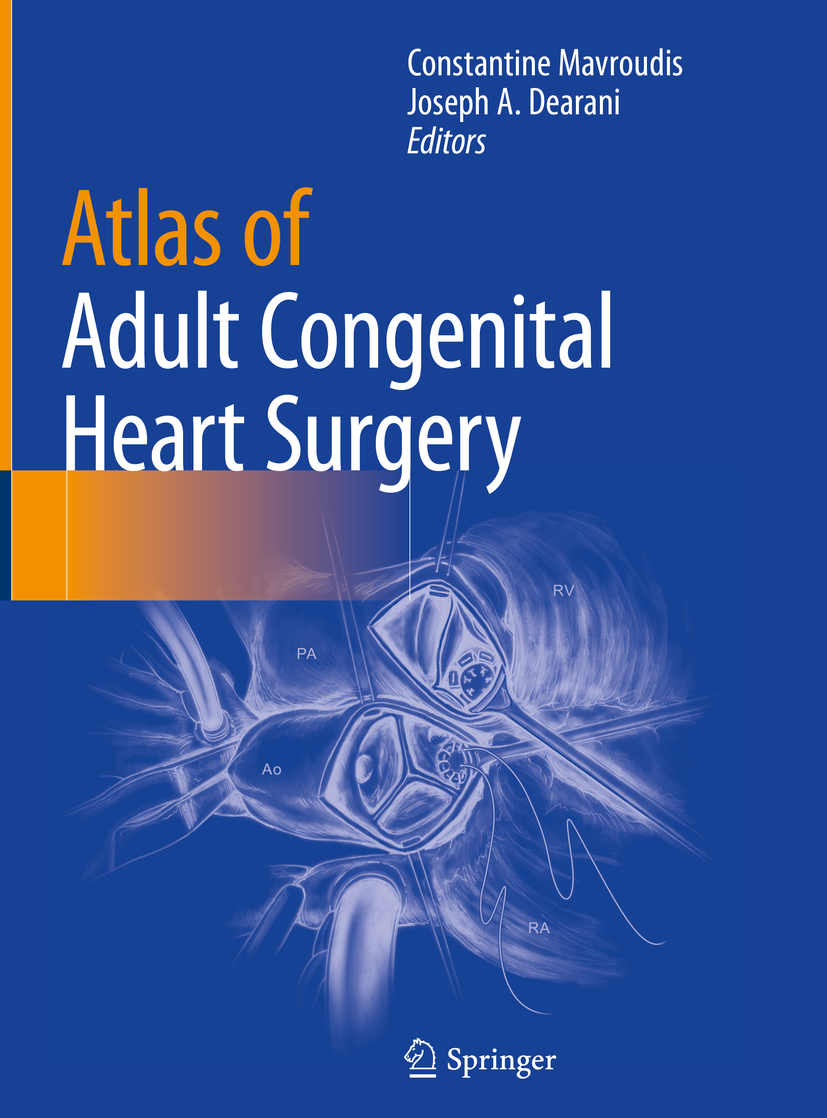Editors
Constantine Mavroudis and Joseph A. Dearani
Atlas of Adult Congenital Heart Surgery
Editors
Constantine Mavroudis
Professor of Surgery, Johns Hopkins University School of Medicine Johns Hopkins All Childrens Hospital, St. Petersburg, FL, USA
Joseph A. Dearani
Professor of Surgery, Department of Cardiac Surgery, Mayo Clinic, Rochester, MN, USA
ISBN 978-3-030-14162-2 e-ISBN 978-3-030-14163-9
https://doi.org/10.1007/978-3-030-14163-9
Springer Nature Switzerland AG 2020
This work is subject to copyright. All rights are reserved by the Publisher, whether the whole or part of the material is concerned, specifically the rights of translation, reprinting, reuse of illustrations, recitation, broadcasting, reproduction on microfilms or in any other physical way, and transmission or information storage and retrieval, electronic adaptation, computer software, or by similar or dissimilar methodology now known or hereafter developed.
The use of general descriptive names, registered names, trademarks, service marks, etc. in this publication does not imply, even in the absence of a specific statement, that such names are exempt from the relevant protective laws and regulations and therefore free for general use.
The publisher, the authors, and the editors are safe to assume that the advice and information in this book are believed to be true and accurate at the date of publication. Neither the publisher nor the authors or the editors give a warranty, express or implied, with respect to the material contained herein or for any errors or omissions that may have been made. The publisher remains neutral with regard to jurisdictional claims in published maps and institutional affiliations.
This Springer imprint is published by the registered company Springer Nature Switzerland AG
The registered company address is: Gewerbestrasse 11, 6330 Cham, Switzerland
Preface
The field of adult congenital heart surgery has been rapidly developing over the last two decades based on the realization that surviving congenital heart patients are living well into adulthood and represent more in numbers than children with congenital heart disease. These adult patients will require lifelong surveillance to treat the possible consequences of arrhythmias, residual lesions, and endocarditis. These realities are in addition to those patients who present in adulthood for the first time with undiagnosed hemodynamically significant lesions that will require intervention of one sort or another.
This growing population of patients has challenged the health-care delivery system which now has to reassess these patients with resources that involve expertise from pediatric practitioners, adult practitioners, pediatric hospitals, adult hospitals, and a whole host of clinical conditions that bridge the gap between pediatric and adult care.
The atlas is structured according to diagnoses and procedures based on the appropriate organizational arrangement. Other appropriate imaging techniques are employed to emphasize the planning and execution of the procedures. Specific issues relating to resternotomy, systemic ventricular function, right and left ventricular outflow tract obstruction, multiple valve dysfunction, and complex pacemaker problems are also addressed. Some drawings have been reproduced from the Atlas of Pediatric Heart Surgery such as Fontan conversion and arrhythmia surgery. A few drawings in other chapters such as VSD, vascular rings, palliative operations, and tetralogy of Fallot have also been replicated. All of these drawings, nevertheless, are uniquely reproduced by Rachid Idriss with the majority being new drawings to capture the essence of adult congenital heart surgery. The accompanying prose has been changed to reflect the difference and important elements that are encountered during operations for adult congenital heart surgery.
There is no specific Adult Congenital Heart Surgery Atlas in print. As a result, there is a significant need for a conscientious teaching tool in the form of an Atlas with annotated technical points that will explain the operation, caution the practitioner on the pitfalls for potential complications, and educate a large population of cardiologists, intensivists, nurses, and other health-care providers.
This Atlas of Adult Congenital Heart Surgery is solely illustrated by Rachid Idriss, MFA. He is a very talented and insightful artist who has instinctive characteristics which guided him to display the anatomy and show the relevant, informative steps of the operation. The pertinent parts of the operations are highlighted and emphasized by hues, texture, and shadows. Ghost representations show the intracardiac anatomy while keeping the epicardial surfaces intact. The surrounding supportive structures are shown for visual relativity, but do not compete for the readers attention, which is appropriately drawn to the central purpose of the procedure. Rachid Idriss is a very unusual fellow. Except to guide the particulars of the operative procedure, we had very little to do with his artistic expression. We merely wrote what came natural to us based on our collective experience. The result is this informative Atlas of Adult Congenital Heart Surgery .
Constantine Mavroudis
Orlando, FL
A Note on Nomenclature
The history and evolution of the English language have been highlighted by historical events which include transformation of the Indo-European language to the Germanic languages and migration to the British Isles in the fifth and sixth centuries where English emerged out of the blending of regional dialects. This was followed by the Norman Conquest in 1066, which brought with it an influx of Northern French, and metamorphosis of Old English, Middle English, and Modern English. At one point in the twelfth and thirteenth centuries, England was trilingual, namely, Old English, the language of the agrarian and worker class; Latin used as the language of government, religion, medicine, and academia; and French, the language of the aristocracy and gentry. It should surprise no one, therefore, that medical nomenclature would retain original remnants of Latin and Greek, both in the original Latin and anglicized versions from Greek.
Some examples of this include truncus arteriosus, patent ductus arteriosus, superior vena cava, and ductus venosus, to name but a few. In modern attempts to provide the plural case for these words, bilateral ductus often become ducti, paired vena cava become venae cavae, and so on. Latin, however, has five declensions. In some cases, the noun declensions that have come into usage are simply wrong. For instance, ductus is a masculine noun and is governed by the fourth declension. In this case, therefore, the nominative plural of ductus should be ductus, not ducti. On the other hand, truncus is a masculine noun governed by the second declension, the nominative plural of which is trunci. To obviate such solecisms and bring congenital heart nomenclature and grammar into the twenty-first century, we have determined that American English words should replace Latin words. In this light, patent ductus arteriosus becomes patent arterial duct, the plural of which changes from patent ducti to patent arterial ducts. Similarly, truncus arteriosus becomes common arterial trunk, the plural of which becomes common arterial trunks.

